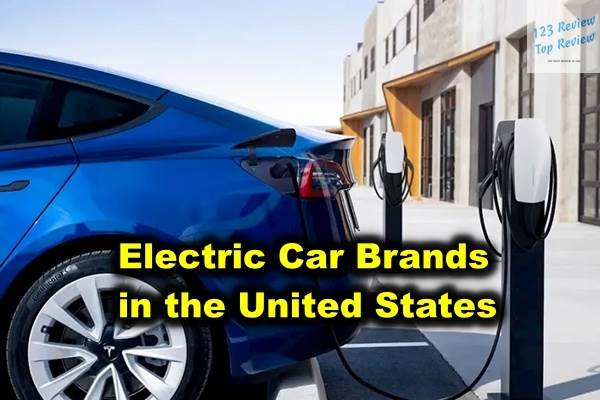As the automotive industry undergoes a profound transformation, electric vehicles (EVs) have emerged as a pivotal force reshaping the market. The United States, a country historically dominated by gasoline-powered cars, is witnessing a significant shift towards electric mobility.

In this article, 123 Review explores the major electric vehicle manufacturers, the types of EVs offered, key models, market trends, charging infrastructure, and the environmental impact of these vehicles.
Major Electric Vehicle Manufacturers
Tesla: Market Leader and Innovations
Tesla is synonymous with electric vehicles and has revolutionized the automotive industry since its inception. Founded by Elon Musk in 2003, Tesla’s mission has been to accelerate the world’s transition to sustainable energy. The company’s impact on the EV market cannot be overstated, as it has consistently set new benchmarks for performance, range, and technological innovation.
Tesla’s lineup includes the Model S, Model 3, Model X, and Model Y. The Model S, a luxury sedan, was Tesla’s first major success, offering an impressive range and unmatched performance. The Model 3, a more affordable sedan, has become the best-selling electric car globally, thanks to its balance of range, performance, and price. The Model X, with its distinctive falcon-wing doors, combines the utility of an SUV with the performance of a sports car, while the Model Y, a compact SUV, caters to the growing demand for crossovers.
What sets Tesla apart is its relentless focus on innovation. The company has pioneered over-the-air software updates, allowing Tesla vehicles to receive new features and improvements remotely. Tesla’s Autopilot and Full Self-Driving (FSD) systems are at the forefront of autonomous driving technology, offering a glimpse into the future of transportation. Moreover, Tesla’s Supercharger network, the largest and fastest-growing EV charging network globally, has alleviated range anxiety for many drivers, making long-distance travel in an electric vehicle more feasible than ever.
Ford: Traditional Automaker’s Transition to EVs
Ford, a name synonymous with American automotive history, has embraced the electric revolution with a determination to lead. Known for its iconic models like the Mustang and the F-150, Ford has leveraged its heritage to create electric versions that appeal to both traditional and new customers.
The Mustang Mach-E, Ford’s first all-electric SUV, represents a bold reimagining of the legendary Mustang. While the Mach-E carries the Mustang name and design cues, it introduces a new era of performance and sustainability. With multiple battery options, the Mach-E offers a range that competes with Tesla, while its driving dynamics ensure that it lives up to the Mustang legacy.
Ford’s most ambitious electric project is the F-150 Lightning, an all-electric version of its best-selling F-150 pickup truck. The F-150 Lightning is designed to meet the needs of truck buyers, offering impressive towing capacity, a large battery that can double as a power source for homes and worksites, and the rugged durability expected from a Ford truck. Ford’s decision to electrify the F-150 underscores its commitment to making electric vehicles mainstream, even among the most loyal truck buyers.
Ford has also announced significant investments in EV production and battery technology, including plans to build new manufacturing facilities dedicated to electric vehicles. This transition marks a critical moment in the company’s history, as it balances its traditional internal combustion engine (ICE) business with a rapidly growing EV portfolio.
Chevrolet: Popular Models and Features
Chevrolet, a brand under the General Motors (GM) umbrella, has been a key player in the American automotive landscape for over a century. In the EV space, Chevrolet has focused on making electric vehicles accessible to the average consumer, offering practical, affordable options that don’t compromise on quality or performance.
The Chevrolet Bolt EV, introduced in 2016, was one of the first affordable electric cars to offer a range that could compete with more expensive models. With a range of over 250 miles on a single charge, the Bolt EV quickly became a popular choice for urban commuters and suburban drivers alike. Its compact design, combined with a surprisingly spacious interior, made it a practical choice for everyday use.
Building on the success of the Bolt EV, Chevrolet introduced the Bolt EUV (Electric Utility Vehicle) in 2021. The Bolt EUV offers more interior space and advanced features like Super Cruise, GM’s hands-free driver assistance technology. This expansion into the electric SUV market demonstrates Chevrolet’s commitment to broadening its EV lineup to meet diverse consumer needs.
Chevrolet’s focus on affordability and practicality is reflected in its pricing strategy, which makes its EVs some of the most accessible on the market. As GM continues to invest in battery technology and electric platforms, Chevrolet is well-positioned to remain a key player in the EV market, offering reliable and cost-effective electric vehicles for a broad audience.
Rivian: Adventure and Utility in Electric Trucks
Rivian is one of the most exciting newcomers in the electric vehicle industry. Founded in 2009 by RJ Scaringe, Rivian has quickly made a name for itself with its focus on adventure-oriented electric trucks and SUVs. While the brand is relatively new, it has attracted significant attention and investment, including backing from Amazon and Ford.
Rivian’s first two models, the R1T electric truck and the R1S electric SUV, are designed for outdoor enthusiasts who want to combine off-road capability with environmental responsibility. The R1T, launched in 2021, is the first mass-produced electric truck in the United States. It features a quad-motor system that provides exceptional power and control, allowing each wheel to operate independently. This capability makes the R1T incredibly versatile, able to handle rugged terrains with ease.
The R1S, Rivian’s electric SUV, shares much of its platform with the R1T but offers three rows of seating, making it a family-friendly option for those who need more passenger space without sacrificing performance. Both the R1T and R1S boast impressive range, advanced technology, and unique features like the Gear Tunnel, a storage space that runs through the width of the vehicle, perfect for storing outdoor gear.
Rivian has also made sustainability a core part of its brand identity. The company is committed to responsible manufacturing practices, including using recycled materials in its vehicles and planning a comprehensive battery recycling program. Rivian’s goal is not just to build electric vehicles but to create a brand that resonates with consumers who prioritize sustainability and adventure.
Electric Vehicle Types Offered
Battery Electric Vehicles (BEVs)
Battery Electric Vehicles (BEVs) represent the purest form of electric mobility, as they rely solely on electricity to power their motors. These vehicles are equipped with large battery packs that store energy, which is then used to drive electric motors. BEVs produce zero tailpipe emissions, making them the most environmentally friendly option among electric vehicles.
Tesla is the most prominent producer of BEVs, with its entire lineup consisting of battery-electric models. Other automakers like Nissan, Chevrolet, and BMW also offer BEVs, each with varying ranges, performance levels, and price points. The absence of an internal combustion engine (ICE) in BEVs results in quieter operation, lower maintenance costs, and the ability to design more spacious and flexible interiors.
The primary concern for BEV owners is range, which refers to the distance a vehicle can travel on a single charge. Over the years, advances in battery technology have significantly increased the range of BEVs, with many modern models offering over 300 miles per charge. This improvement, combined with the growing network of charging stations, has made BEVs more practical for everyday use and long-distance travel.
Plug-in Hybrid Electric Vehicles (PHEVs)
Plug-in Hybrid Electric Vehicles (PHEVs) bridge the gap between traditional hybrid vehicles and fully electric cars. PHEVs are equipped with both an electric motor and an internal combustion engine (ICE). They can operate in all-electric mode for short distances, typically between 20 and 50 miles, after which the ICE takes over to extend the vehicle’s range. This dual powertrain offers flexibility, allowing drivers to use electric power for short commutes and gasoline for longer trips without worrying about recharging.
Ford, Toyota, and Honda are among the automakers that offer PHEVs in their lineups. The Ford Escape Plug-in Hybrid, Toyota Prius Prime, and Honda Clarity PHEV are popular models that combine the benefits of electric driving with the convenience of a gasoline engine. PHEVs are particularly appealing to drivers who want to reduce their carbon footprint but may not have easy access to charging infrastructure.
One of the key advantages of PHEVs is their ability to reduce fuel consumption and emissions while offering the convenience of gasoline when needed. This makes them an attractive option for drivers who are not ready to fully transition to an electric vehicle but still want to contribute to a more sustainable future.
Hybrid Electric Vehicles (HEVs)
Hybrid Electric Vehicles (HEVs) are the predecessors of modern electric vehicles, combining an internal combustion engine with an electric motor. Unlike PHEVs, HEVs do not plug in to charge; instead, they rely on regenerative braking and the ICE to recharge the battery. The electric motor assists the engine during acceleration and low-speed driving, improving fuel efficiency and reducing emissions.
Toyota’s Prius is the most iconic HEV, having popularized hybrid technology worldwide. Other automakers, including Honda, Ford, and Hyundai, also offer HEVs in their lineups. HEVs are known for their reliability, fuel efficiency, and lower emissions compared to traditional gasoline-powered vehicles.
HEVs are an excellent choice for drivers who want to reduce their fuel consumption and carbon footprint without worrying about charging infrastructure. While they do not offer the same environmental benefits as BEVs or PHEVs, HEVs represent a significant step towards cleaner transportation.
Key Electric Vehicle Models
Tesla Model 3: Affordability and Performance
The Tesla Model 3 is often credited with bringing electric vehicles into the mainstream. Introduced in 2017, the Model 3 was Tesla’s first attempt at creating a more affordable electric car that could appeal to a broader audience. The strategy paid off, as the Model 3 quickly became the best-selling electric vehicle globally.
The Model 3 is available in several configurations, including Standard Range Plus, Long Range, and Performance versions. The Long Range model offers over 350 miles of range, making it one of the longest-range EVs on the market. The Performance model, true to its name, delivers sports car-like acceleration, with a 0-60 mph time of just 3.1 seconds.
One of the standout features of the Model 3 is its minimalist interior design, dominated by a 15-inch touchscreen that controls nearly all of the car’s functions. Tesla’s over-the-air software updates ensure that the Model 3 continues to improve over time, with new features and improvements delivered directly to the vehicle.
The Model 3’s combination of affordability, range, and performance has made it a favorite among consumers and a benchmark for other automakers entering the EV market. It has also helped establish Tesla as the market leader in electric vehicles.
Ford Mustang Mach-E: An Icon Reimagined
The Ford Mustang Mach-E represents a bold new direction for Ford, blending the heritage of the Mustang with the innovation of electric vehicles. Launched in late 2020, the Mach-E is Ford’s first all-electric SUV and a clear statement of the company’s commitment to electrification.
The Mach-E is available in several trims, including the base Select model, the California Route 1 with extended range, the sporty GT, and the luxurious Premium model. Depending on the configuration, the Mach-E offers a range of up to 305 miles on a single charge. The GT model, designed for performance enthusiasts, boasts 480 horsepower and a 0-60 mph time of just 3.5 seconds.
Inside, the Mach-E features a modern, tech-forward design with a large vertical touchscreen, a digital instrument cluster, and a panoramic glass roof. The vehicle also supports Ford’s SYNC 4A system, which offers enhanced voice recognition, cloud-based navigation, and over-the-air updates.
The Mustang Mach-E has been praised for its combination of style, performance, and practicality. It appeals to both traditional Mustang fans and new customers looking for a stylish and capable electric SUV. The Mach-E is a critical part of Ford’s strategy to electrify its lineup and compete with Tesla and other EV manufacturers.
Chevrolet Bolt EV: Value in the Electric Market
The Chevrolet Bolt EV has played a significant role in making electric vehicles more accessible to the mass market. When it was introduced in 2016, the Bolt EV was one of the first affordable electric cars to offer a range of over 200 miles, setting a new standard for practicality and value in the EV segment.
The Bolt EV features a compact hatchback design, making it ideal for city driving and tight parking spaces. Despite its small size, the Bolt EV offers a spacious interior with comfortable seating for five and ample cargo space. The vehicle is powered by a 66 kWh battery, which provides an EPA-estimated range of 259 miles on a single charge.
Chevrolet has also focused on making the Bolt EV user-friendly, with features like one-pedal driving, which allows the driver to control acceleration and deceleration using just the accelerator pedal. The Bolt EV’s infotainment system includes a 10.2-inch touchscreen with Apple CarPlay, Android Auto, and a variety of EV-specific features, such as energy usage tracking and range estimation.
In 2021, Chevrolet expanded its electric lineup with the introduction of the Bolt EUV, a larger version of the Bolt EV that offers more passenger space and advanced features like Super Cruise, GM’s hands-free driving assistance technology. The Bolt EUV shares the same powertrain as the Bolt EV but adds features and space that make it more appealing to families and those looking for a bit more room.
The Bolt EV and Bolt EUV represent Chevrolet’s commitment to providing affordable, practical electric vehicles that meet the needs of a wide range of consumers. With competitive pricing and a solid range, the Bolt EV remains a strong contender in the growing electric vehicle market.
Rivian R1T: Designed for Off-Road Capability
The Rivian R1T is a groundbreaking electric truck that combines rugged off-road capability with the sustainability of electric power. Launched in 2021, the R1T is Rivian’s first production vehicle and the first all-electric truck to hit the market in the United States.
The R1T is designed for adventure, with a quad-motor system that delivers power to each wheel independently, providing unmatched control and traction on challenging terrain. The truck is capable of wading through water over three feet deep, climbing steep grades, and traversing rough trails with ease. This makes it an ideal choice for outdoor enthusiasts who want a vehicle that can handle off-road adventures while minimizing their environmental impact.
One of the R1T’s most unique features is its Gear Tunnel, a storage space that runs through the truck’s body between the cab and the bed. This tunnel is perfect for storing long items like skis, snowboards, or camping gear. The R1T also offers a variety of bed configurations, including a built-in air compressor and a power outlet, making it a versatile tool for work and play.
The R1T’s interior is both luxurious and practical, with premium materials, a large touchscreen display, and a spacious cabin that comfortably seats five. The truck’s battery provides a range of over 300 miles, and Rivian has plans to expand its charging network to support long-distance travel and off-road adventures.
Rivian’s focus on sustainability is evident not only in its vehicles but also in its business practices. The company is committed to using recycled and sustainable materials in its production process and has ambitious plans for battery recycling and reducing its overall environmental impact.
The R1T has set a new standard for electric trucks, offering a combination of capability, luxury, and sustainability that appeals to a broad range of consumers. As Rivian continues to grow, the R1T is likely to remain a key player in the electric truck market.
Electric Vehicle Market Trends
Growth in EV Adoption Rates
The adoption of electric vehicles in the United States has accelerated rapidly in recent years. This growth is driven by a combination of factors, including increasing environmental awareness, advancements in battery technology, expanding charging infrastructure, and supportive government policies.
According to recent studies, the number of electric vehicles on U.S. roads has more than doubled over the past five years, with EVs accounting for approximately 6% of new car sales in 2023. This growth is expected to continue, with projections suggesting that EVs could make up 25% of new car sales by 2030.
Several factors are contributing to this rapid adoption. First, the cost of electric vehicles has decreased significantly, making them more accessible to a broader range of consumers. Battery technology has improved, leading to longer ranges and faster charging times, which have helped alleviate range anxiety, a common concern among potential EV buyers.
In addition, the expansion of public charging networks has made it easier for EV owners to find charging stations, particularly in urban areas. Companies like Tesla, Electrify America, and ChargePoint have invested heavily in building out charging infrastructure, ensuring that EV drivers have access to reliable and convenient charging options.
Government policies have also played a crucial role in promoting EV adoption. Federal and state tax incentives, rebates, and grants have made EVs more affordable, while stricter emissions regulations have encouraged automakers to invest in electric vehicle development.
As consumer awareness of the environmental and economic benefits of electric vehicles continues to grow, the U.S. is likely to see a significant increase in EV adoption rates in the coming years.
Impact of Tax Incentives on Sales
Tax incentives have been a key driver of electric vehicle sales in the United States. The federal government currently offers a tax credit of up to $7,500 for the purchase of a new electric vehicle, depending on the vehicle’s battery capacity and the manufacturer’s sales volume.
These incentives have made electric vehicles more affordable for consumers, reducing the price gap between EVs and traditional gasoline-powered cars. For many buyers, the tax credit is a deciding factor when considering an EV purchase, as it can significantly reduce the upfront cost.
In addition to federal incentives, many states offer their own incentives for electric vehicle purchases. These can include rebates, tax credits, reduced registration fees, and access to carpool lanes. States like California, New York, and Colorado have some of the most generous EV incentives, which have contributed to higher EV adoption rates in these regions.
However, the future of these incentives is uncertain. The federal EV tax credit begins to phase out once an automaker sells 200,000 qualifying vehicles, which has already affected manufacturers like Tesla and General Motors. Policymakers are currently debating changes to the incentive program, including potential extensions or modifications that would make the credit more widely available.
Despite this uncertainty, tax incentives have had a significant impact on the growth of the EV market in the U.S., making electric vehicles more accessible and accelerating their adoption.
Consumer Preferences: Range, Price, and Features
When it comes to electric vehicles, consumer preferences are evolving rapidly. Three key factors typically influence purchasing decisions: range, price, and features.
Range: Range anxiety, or the fear of running out of battery power before reaching a charging station, has been one of the biggest barriers to EV adoption. As a result, range is a top priority for many consumers. Modern electric vehicles offer significantly improved ranges, with many models exceeding 300 miles on a single charge. Tesla, for example, has set the standard for range with its Long Range models, while other automakers are working to close the gap.
Price: Price remains a critical factor for many potential EV buyers. While electric vehicles have traditionally been more expensive than their gasoline counterparts, the cost has decreased significantly over the past decade. Advances in battery technology and increased production have driven down prices, making EVs more competitive with traditional vehicles. Additionally, government incentives have made EVs more affordable, further driving adoption.
Features: In addition to range and price, consumers are increasingly looking for advanced features in their electric vehicles. These include cutting-edge technology like autonomous driving capabilities, over-the-air software updates, and enhanced connectivity. Safety features, such as advanced driver assistance systems (ADAS), are also important considerations. Automakers like Tesla, Ford, and Rivian are leading the way in integrating these technologies into their vehicles, making them more appealing to tech-savvy consumers.
As the electric vehicle market continues to grow, manufacturers are responding to consumer demands by offering a wider range of models with varying ranges, price points, and features. This increased competition is likely to benefit consumers, providing more options to suit different needs and preferences.
Charging Infrastructure and Solutions
Overview of Public Charging Networks
One of the most significant challenges facing electric vehicle adoption is the availability of charging infrastructure. To support the growing number of EVs on the road, a robust network of public charging stations is essential. Fortunately, the U.S. has seen substantial investment in public charging networks, with both private companies and government agencies working to expand access.
Tesla’s Supercharger network is the most well-known and extensive public charging network in the world. With thousands of Superchargers located across the U.S., Tesla owners can quickly and conveniently charge their vehicles on long trips. Superchargers are designed to provide high-speed charging, with some stations capable of adding up to 200 miles of range in just 15 minutes.
Other companies, such as Electrify America, ChargePoint, and EVgo, have also made significant strides in building public charging networks. Electrify America, in particular, has invested billions of dollars in creating a nationwide network of fast-charging stations. These stations are compatible with a wide range of electric vehicles and offer charging speeds comparable to Tesla’s Superchargers.
Public charging stations are typically located in high-traffic areas such as shopping centers, parking garages, and along major highways. This strategic placement makes it convenient for EV owners to charge their vehicles while going about their daily activities or during long road trips.
While public charging networks have expanded significantly in recent years, there are still gaps in coverage, particularly in rural areas. Addressing these gaps will be crucial to ensuring that electric vehicles are a viable option for all Americans, regardless of where they live.
Home Charging Options for EV Owners
For most electric vehicle owners, home charging is the most convenient and cost-effective way to charge their vehicles. Home charging stations, also known as Level 2 chargers, can be installed in a garage or driveway and provide a faster charging rate than a standard household outlet.
Level 2 chargers typically require a 240-volt outlet, similar to what is used for large appliances like dryers. These chargers can add anywhere from 10 to 60 miles of range per hour, depending on the vehicle’s battery size and the charger’s power output. Most EV owners find that overnight charging provides enough range for their daily needs, making home charging a practical solution for everyday use.
Installing a home charging station typically requires a licensed electrician, and the cost can vary depending on the complexity of the installation. However, many utilities and government programs offer rebates or incentives to help offset the cost of purchasing and installing a home charger.
Some EV owners also take advantage of time-of-use (TOU) electricity rates, which offer lower rates during off-peak hours. By charging their vehicles during these times, owners can reduce their electricity costs and make the most of their home charging setup.
For those who cannot install a home charger, such as apartment dwellers or renters, workplace charging or reliance on public charging networks may be necessary. As the EV market continues to grow, more solutions for home and workplace charging are likely to emerge, making it easier for all drivers to transition to electric vehicles.
Fast Charging vs. Level 2 Charging Stations
When it comes to charging electric vehicles, drivers have two primary options: fast charging and Level 2 charging. Each option has its advantages and is suited to different needs and situations.
Fast Charging: Fast charging, also known as DC fast charging or Level 3 charging, is the quickest way to charge an electric vehicle. Fast chargers can add up to 200 miles of range in as little as 15-30 minutes, making them ideal for long trips or when a quick top-up is needed. Fast charging stations are typically found along highways, at rest stops, and in other high-traffic areas. While fast charging is convenient, it can be more expensive than Level 2 charging and may reduce battery lifespan if used frequently.
Level 2 Charging: Level 2 charging is slower than fast charging but is more commonly used for everyday charging. Level 2 chargers are typically found at homes, workplaces, and public charging stations. They provide a charging rate of 10-60 miles of range per hour, depending on the charger’s power output and the vehicle’s battery size. While Level 2 charging takes longer, it is more cost-effective and less likely to degrade the battery over time.
Most EV owners use a combination of both charging methods, relying on Level 2 charging for daily use and fast charging for longer trips or when time is of the essence. As charging infrastructure continues to expand, drivers will have more options and flexibility in how they charge their vehicles, making electric vehicles an increasingly practical choice for all types of driving needs.
Environmental Impact and Sustainability
Reducing Carbon Footprint with Electric Vehicles
One of the primary motivations for the shift to electric vehicles is the potential to reduce greenhouse gas emissions and combat climate change. Unlike traditional gasoline-powered vehicles, electric vehicles produce zero tailpipe emissions, which significantly reduces their carbon footprint.
The environmental benefits of electric vehicles are most pronounced when they are charged using renewable energy sources such as wind, solar, or hydroelectric power. When powered by renewable energy, EVs can have a nearly zero-carbon footprint, making them one of the most sustainable transportation options available.
Even when charged using electricity generated from fossil fuels, EVs are still generally cleaner than gasoline-powered vehicles. This is because electric motors are more efficient than internal combustion engines, and electricity generation is often subject to stricter emissions regulations than vehicle emissions.
In addition to reducing greenhouse gas emissions, electric vehicles also contribute to improved air quality, particularly in urban areas. By eliminating tailpipe emissions, EVs reduce the levels of harmful pollutants such as nitrogen oxides (NOx) and particulate matter (PM), which are associated with respiratory and cardiovascular health problems.
As more renewable energy sources are integrated into the grid and as EV adoption continues to grow, the overall environmental impact of transportation is expected to decrease, contributing to a more sustainable future.
Lifecycle Emissions of Electric Vehicles
While electric vehicles offer significant environmental benefits, it is important to consider their lifecycle emissions, which include the emissions associated with manufacturing, operation, and disposal.
The production of electric vehicles, particularly the manufacturing of batteries, is more energy-intensive than the production of traditional gasoline-powered vehicles. This is due to the mining and processing of materials such as lithium, cobalt, and nickel, which are used in EV batteries. As a result, the carbon footprint of manufacturing an EV is generally higher than that of a conventional vehicle.
However, over the lifetime of the vehicle, EVs typically have lower overall emissions due to their zero tailpipe emissions and higher efficiency. The longer an EV is driven, the more its lower operational emissions offset the higher emissions from production. Studies have shown that, over their entire lifecycle, EVs can produce significantly lower emissions than traditional vehicles, particularly when charged with clean energy.
Recycling and repurposing EV batteries can also reduce the lifecycle emissions of electric vehicles. As the EV market grows, so does the importance of developing efficient recycling processes for batteries, which can recover valuable materials and reduce the environmental impact of battery production.
Recycling and Disposal of EV Batteries
The sustainability of electric vehicles extends beyond their operation to include the recycling and disposal of EV batteries. As the number of electric vehicles on the road increases, so does the need for effective solutions to manage the end-of-life batteries.
EV batteries are typically made from lithium-ion cells, which contain valuable materials such as lithium, cobalt, nickel, and manganese. These materials can be recovered and reused in the production of new batteries, reducing the need for mining and minimizing environmental impact. Recycling also helps to prevent hazardous materials from entering the environment, which can occur if batteries are improperly disposed of.
Several companies and research institutions are working on developing advanced battery recycling technologies. These processes aim to increase the efficiency of material recovery, reduce the environmental impact of recycling, and lower the cost of producing new batteries. As these technologies continue to improve, the recycling of EV batteries is expected to become a key component of the sustainable electric vehicle ecosystem.
In addition to recycling, some EV batteries can be repurposed for second-life applications. For example, used EV batteries can be used in energy storage systems, providing a cost-effective solution for storing renewable energy or providing backup power. Repurposing batteries extends their useful life and further reduces their environmental impact.
As the electric vehicle market continues to grow, the development of sustainable solutions for battery recycling and disposal will be critical to ensuring that the benefits of electric vehicles are fully realized.
Conclude
Electric vehicles are no longer a niche market; they are becoming the new standard for transportation in the United States. As more consumers recognize the environmental, economic, and performance benefits of EVs, the market is poised for continued growth. With advancements in technology, expanding infrastructure, and a commitment to sustainability, electric vehicles represent the future of mobility in the U.S. and beyond.





